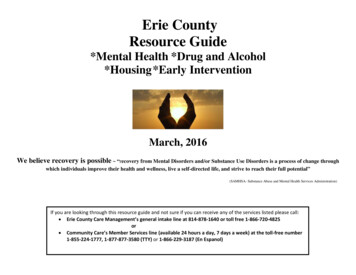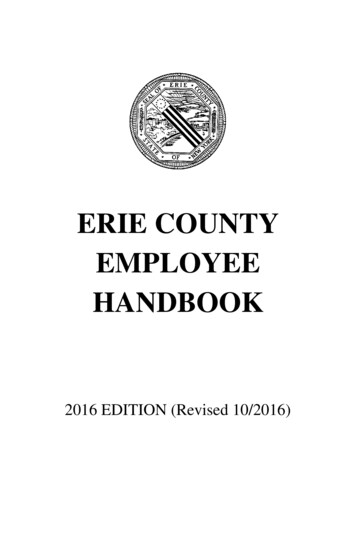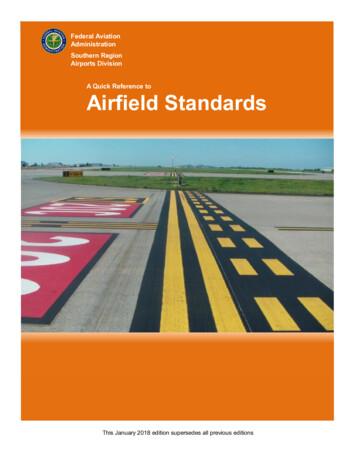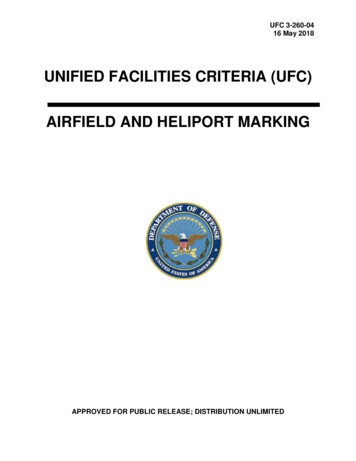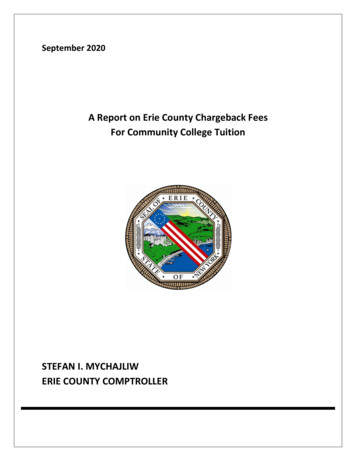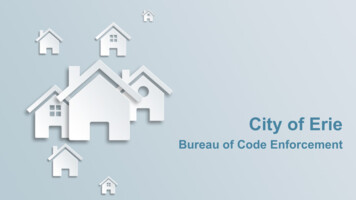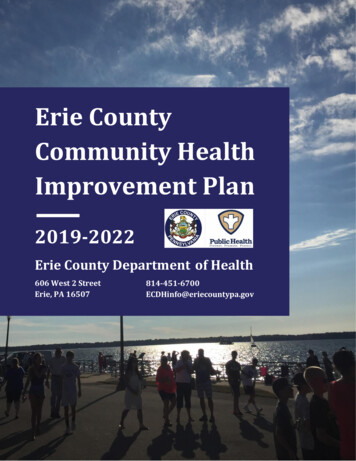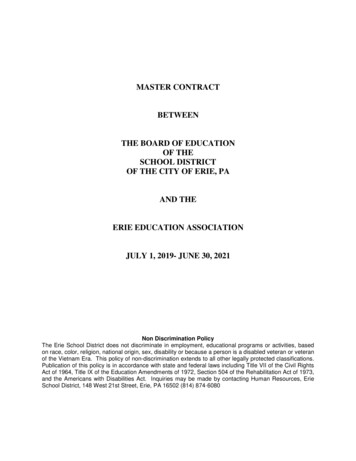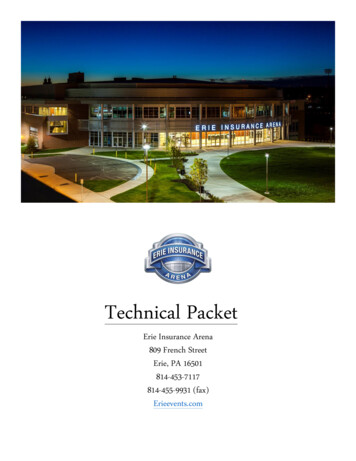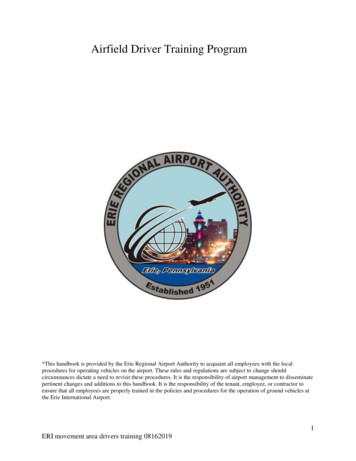
Transcription
Airfield Driver Training Program*This handbook is provided by the Erie Regional Airport Authority to acquaint all employees with the localprocedures for operating vehicles on the airport. These rules and regulations are subject to change shouldcircumstances dictate a need to revisit these procedures. It is the responsibility of airport management to disseminatepertinent changes and additions to this handbook. It is the responsibility of the tenant, employee, or contractor toensure that all employees are properly trained in the policies and procedures for the operation of ground vehicles atthe Erie International Airport.1ERI movement area drivers training 08162019
Table of ContentsINTRODUCTION .3DRIVERS TRAINING .4NON-COMPLIANCE.5DEFINITIONS .7REGULATIONS .11THE AIRPORT OPERATING AREA .14AIRPORT VISUAL AIDS .20RUNWAY SAFETY .27AOA HAZARDS.30RADIO COMMUNICATIONS .34LESSONS LEARNED EVENTS . 40APPENDIX A – TRAINING CURRICULUM . .42APPENDIX B – MOVEMENT / NON-MOVEMENT AREA DEPICTION .45APPENDIX C – AIRPORT DIAGRAM .46APPENDIX D – RUNWAY SAFETY AREAS .47APPENDIX E –AOA OPERATORS TRAINING GUIDE.48APPENDIX F – PRACTICAL SKILLS EVALUATION 50APPENDIX G – PEDESTRIAN AND GROUND VEHICLES REQUIREMENTS. .52APPENDIX H -- TEST QUESTIONS . . 56APPENDIX I – FAA LOA AIRPORT MOVEMENT AREAS . 60APPENDIX J – DRIVERS TRAINING RECORD FORM .622ERI movement area drivers training 08162019
IntroductionThis handbook presents guidelines and procedures designed to enhance the safety and efficiencyof the Airport Operating Area (AOA). In addition, the implementation of this program isintended to assist in the elimination of runway incursions. This handbook contains informationwhich should be thoroughly understood by all persons who intend to operate on the AOA.It is extremely important that all persons who conduct AOA operations have a thoroughunderstanding of the runway and airfield layout at the Erie International Airport (ERI) as well asfamiliarity with applicable Air Traffic Control Tower (ATCT) procedures. Formal AOA trainingand the successful completion of all mandatory evaluations are required for all personsexercising AOA driving privileges at the Erie International Airport.Only individuals who have successfully completed the AOA Drivers Training Program will bepermitted to conduct AOA Driving operations at ERI. Persons who successfully complete theAOA Drivers Training Program and evaluation process will be issued an AOA Drivers Permit.Any violation of the Rules & Regulations can result in the loss of your ID badge and remedialactions will be taken.SeverabilityIf any section, subsection, subdivision, paragraph, sentence, clause, or phrase of these rules andregulations or any part thereof is for any reason held to be unconstitutional, invalid, orineffective by any court of competent jurisdiction or other competent agency, such decision willnot affect the validity or effectiveness of remaining portions of these rules and regulations.3ERI movement area drivers training 08162019
Drivers TrainingDrivers Training consists of both initial and recurrent instruction. Training can be scheduledthroughout the year. Recurrent training is conducted annually. It is the responsibility of theemployer and/or department supervisor to ensure that the applicant is ready to operate as acompetent AOA driver. Prior to scheduling training, the applicant should spend time with his orher employer and/or department supervisor by reviewing this handbook. The applicant shouldhave a complete knowledge of the material and have good practical knowledge of operating onthe airfield. Please contact the Airport Authority at (814) 833-4258 if you have any questionsregarding the training process.Initial TrainingNew AOA Driver applicants are required to complete initial training prior to receiving AOAdriving privileges at the Erie International Airport. It is the responsibility of the employer and/ordepartment supervisor to ensure that the applicant is ready to operate as a competent AOADriver.Upon successful completion of the above requirements, the applicant, employer, and/ordepartment supervisor shall fill out and sign an AOA Vehicle Operator Application. Theemployer and/or department supervisor may then contact the Airport Authority at (814) 8334258 to schedule the formal AOA drivers training session and evaluation.The formal evaluation for new drivers will be completed by a designated AOA Drivers TrainingInstructor/Examiner and consist of the following:1.2.3.4.An oral review including a presentation appropriate to the working season.A video presentation.A written knowledge exam consisting of both multiple-choice and true/false questions.An airfield AOA practical driving test.In order to successfully complete the initial training, the applicant must successfully completethe written exam with a passing score of 90% or better and pass the practical driving test asdetermined by the designated Examiner.Recurrent TrainingTo maintain AOA driving privileges, each authorized AOA Driver must also complete annualrecurrent training within 365 days of initial or previous recurrent training. This recurrent trainingis intended to refresh drivers of the operating hazards and any special conditions that may exist.Failure to participate in this required recurrent training will result in the revocation of AOAprivileges. The individual will be required to reapply and pass all phases of the AOA driverstraining program to earn back his or her AOA driving privileges.AOA Drivers should study and review the Vehicle Operator’s Handbook prior to recurrenttraining. Recurrent training will be in a manner sufficient to allow the driver maintain4ERI movement area drivers training 08162019
knowledge and proficiency to safely and effectively operate within the movement area(s)Retesting After FailureMovement Area driver applicants must successfully pass both the written and practical drivingportion of the test. Applicants who fail any portion of the test are not permitted to operate on theAOA unless accompanied by an individual with AOA driving privileges. An applicant will onlybe retested in the area in which he or she has failed. For example, an individual who passes thewritten portion but fails the driving portion will only be required to retest on the driving portion.A minimum score of 90% is required to successfully pass the written exam. Applicants who failthe written portion of the examination will be instructed to take adequate time to thoroughlystudy and review the information in the AOA Vehicle Operator and Pedestrian Handbook. Afterthe applicant is prepared, he or she may be allowed to retest during the next scheduled trainingclass.An applicant who fails the practical driving evaluation will immediately be critiqued on the areasof deficiency by the examiner. He or she may schedule a retest only after they complete trainingin the areas of deficiency with their employer and/or department supervisor.A Movement Area Drivers Application must be completed by the applicant, employer, and/orsupervisor prior to each retest.Non-ComplianceEnforcement of the pedestrian and ground vehicle procedures and rules are applicable to airportemployees, tenants and contractors and all instances of non-compliance shall be handled by theAirport Executive Director.Surveillance shall be maintained to ensure that only authorized vehicles and persons operate onthe AOA and regulations are followed.When violations are observed or reported appropriate action will be taken. In the event a report isreceived of unauthorized vehicles or persons on the AOA, an Airport Operations vehicle, orAirport Law Enforcement vehicle will be dispatched to intercept and escort the violator from thearea. A report will be prepared and kept on file concerning all incidents. Appropriate correctiveaction will be taken as determined by the Airport Executive Director.Consequences1. First Offense:a. The individuals SIDA badge will be confiscated.b. The individual will receive a permanent letter of non-compliance of federalregulation and driving privileges will be revoked for a minimum of 3 calendardays.c. If the violator is a tenant or contractor, the individual’s organization/tenant groupsecurity liaison will receive notification of non-compliance of federal regulationand driving privileges will be revoked for the driver for a minimum of 3 calendardays.5ERI movement area drivers training 08162019
d. The individual will be required to submit a written, detailed report describing thesurface incident to the Airport Executive Director.e. AOA drivers will complete AOA drivers training to include both written andpractical testing of airfield driving procedures.f. Upon successful completion of the AOA driver’s training, the driver’s immediatesupervisor is required to conduct a ride along to observe the driver on themovement areas for 10 calendar work shifts. The supervisor is required to submita detailed letter to the Airport Executive Director, who will approve or denyunescorted access and airfield driving privileges to the driver.2. Second Offense:a. The individuals SIDA badge will be confiscated.b. The individual will receive a permanent letter of non-compliance of federalregulation and driving privileges will be revoked for a minimum of 15 calendardays.c. If the violator is a tenant or contractor, the individual’s organization/tenant groupsecurity liaison will receive notification of non-compliance of federal regulationand driving privileges will be revoked for the driver for a minimum of 15 calendardays.d. The individual will be required to submit a written, detailed report describing thesurface incident to the Airport Executive Director.e. AOA drivers will complete AOA drivers training to include both written andpractical testing of airfield driving procedures.f. Upon successful completion of the AOA driver’s training, the driver’s immediatesupervisor is required to conduct a ride along to observe the driver on themovement areas for 10 calendar work shifts. The supervisor is required to submita detailed letter to the Airport Executive Director, who will approve or denyunescorted access and airfield driving privileges to the driver.3. Third Offense:a. The individuals SIDA access will be permanently revoked and will be bannedfrom unescorted pedestrian or vehicular access to any restricted or secured areasof the airport.6ERI movement area drivers training 08162019
DefinitionsAccident – A collision between one aircraft or vehicle and another aircraft, vehicle, person, orobject that results in property damage, personal injury, or death.Air Carrier Ramp – a ramp for air carriers. Only authorized personnel and vehicles may operateon this ramp. Private vehicles and aircraft are prohibited from operating on itAircraft – A device that is used or intended to be used for flight in the air.Aircraft Rescue & Firefighting (ARFF) – Specialty equipment and personnel trained to respondto airport emergencies for airport rescue and firefighting.Airport Operations Area (AOA) – The AOA consists of all restricted ground areas of the airport,including taxiways, runways, loading ramps, and parking areas. In other words, everything that isinside the perimeter fence. The AOA is divided into two distinct areas: the ‘Movement’ area andthe ‘Non-movement’ area.Airside – Those areas of an airport that support aircraft activities.Airport – Erie International Airport, Tom Ridge Field, owned and operated by the Erie RegionalAirport Authority including all improvements and equipment existing or to be developed.Airport Traffic Control Tower (ATCT) – A facility using air to ground communications, visualsignaling and other devices to provide air traffic control services to aircraft operating in thevicinity of the airport or on the movement area.Apron or Ramp – Area designed for loading or unloading passengers and/or cargo, refueling,catering, parking or maintenance of aircraft.Common Traffic Advisory Frequency (CTAF) – Radio frequency designed for the purpose ofcarrying out airport advisory practices while operating to or from an airport without an operatingATCT or when the tower is closed. The common traffic advisory frequency at the ErieInternational Airport is 122.95 MHz.Federal Aviation Administration (FAA) – The federal agency charged with the administrationand oversight of the national airspace system, including, but not limited to, air traffic control andairport security.Fixed Base Operator (FBO) – a person, firm, or organization engages in a business thatprovides a range of basic services to general aviation. Services may include the sale anddispensing of fuel, line services, aircraft parking and tie-down, pilot and passenger facilities,airframe and power plant maintenance, aircraft sales and rental, and pilot instruction.Flight Service Station (FSS) – air traffic facilities that provide pilot briefings, en routecommunications, and visual flight rules search and rescue services; assist lost aircraft and aircraftin emergency situations; relay air traffic control clearances; originate Notices to Airmen;7ERI movement area drivers training 08162019
broadcast aviation weather and National Airspace System information; receive and processinstrument flight rules flight plans; and monitor NAVAIDS. In addition, at selected locations,FSSs provide En Route Flight Advisory Service (Flight Watch), take weather observations, issueairport advisories, and advise Customs and Immigration of transborder flights.Foreign Object Debris (FOD) – debris that can cause damage to aircraft engines, tires, or skinfrom rocks, trash, or the actual debris found on runways, taxiways, and aprons.General Aviation (GA) – That portion of civil aviation that encompasses all facets of aviationexcept air carriers holding a certificate of public convenience and necessity.Ground Vehicle – All conveyances, except aircraft, used on the ground to transport persons,cargo, fuel, or equipment.Hold Short Line – A pavement marking made up of two solid yellow stripes followed by twobroken (dashed) stripes located across a taxiway. The solid stripes of this marking must beconsidered like a STOP sign. The marking means you are near an active runway. You mustreceive clearance via radio from the Air Traffic Control Tower to cross a hold line and enter arunway.ILS Critical Area – An area provided to protect the signals of the localizer and Glide-slope.Incursion – any occurrence at an airport involving an aircraft, vehicle, person, or object on theground that creates a collision hazard or results in loss separation with an aircraft taking off,intending to take off, landing or intending to land.Jet Blast – Jet engine exhaust or propeller wash (thrust stream turbulence).Law Enforcement Officer (LEO) – any person vested with police power of arrest under Federal,State, County, or City authority and identifiable by uniform, badge and other indication ofauthority.Light Gun – a hand held, directional light-signaling device that emits a bright narrow beam ofwhite, green, or red light, as selected by the tower controller. The color and type of lighttransmitted can be used to approve or disapprove anticipated pilot or vehicle actions where radiocommunication is not available. The light gun is used for controlling traffic operating in thevicinity of an airport and on the airport movement area.Mobil Fueler – a vehicle owned and/or operated by authorized agents to pump and dispense JetA and 100LL fuel at ERI.Movement Area – the runways, taxiways, and other areas of an airport that aircraft use fortaxiing, takeoff, and landing, exclusive of loading ramps and parking areas, and that are underthe control of an air traffic control tower.8ERI movement area drivers training 08162019
MULTICOM – a mobile service not open to public correspondence used to providecommunications essential to conduct the activities being performed or directed from privateaircraft.Navigational Aids (NAVAIDS) – Electronic equipment located near runways and taxiways.They provide horizontal and/or vertical guidance to aircraft.Non-Movement Areas – taxiways, aprons, and other areas not under the control of air traffic orat airports without an operating airport traffic control tower.Operator – any person who is in actual physical control of an aircraft or motor vehicle.Owner – a person who holds the legal title of an aircraft or motor vehicle.Pedestrian – Person on foot.Restricted Areas – areas of the airport posted to prohibit or limit entry or access by the generalpublic. All areas other than public areasRunway - A defined rectangular surface on a land airport prepared for the landing and takeoffrun of aircraft along its length.Runway in Use or Active Runway – any runways or runway currently being used for takeoff orlanding. When multiple runways are in use, they are all considered active runways.Runway Safety Area - a defined surface surrounding the runway prepared or suitable forreducing the risk of damage to airplanes in the event of an undershoot, overshoot, or excursionfrom the runway.Security Identification Display Area (SIDA) - A TSA designated restricted area. Each personmust wear an airport issued or airport approved identification medium on your outermostgarment unless under airport approved escort.Surface Movement Guidance and Control System (SMGCS) – a system comprising theprovisions for guidance to, and control or regulation of all aircraft, ground vehicles, andpersonnel of the airport during low-visibility operations. Guidance relates to facilities andinformation necessary for pilots and ground vehicle operators to find their way about the airport.Control or regulation means the measures necessary to prevent collisions and to ensure thattraffic flows smoothly and efficiently.Taxiway – those parts of the airside designated for the surface maneuvering of aircraft to andfrom the runways and aircraft parking areas.Tie Down Area – an area used for securing aircraft to the ground.9ERI movement area drivers training 08162019
Uncontrolled Airport – an airport without an operating airport traffic control tower or whenairport traffic control tower is not operating.UNICOM – a non-Federal communication facility that may provide airport information atcertain airports. Locations and frequencies of UNICOMs are shown on aeronautical charts andpublications.Vehicle Service Road – a designated roadway for vehicles in a non-movement area.Very High Frequency Omnidirectional Range (VOR) – a ground-based electronic navigationaid transmitting very high frequency navigational signals, 360 degrees azimuth, orientated frommagnetic north. Used as the basis for navigation in the National Airspace System.Wake Turbulence – phenomenon resulting from the passage of an aircraft through theatmosphere. The term includes vortices, thrust stream turbulence, jet blast, jet wash, propellerwash, and rotor wash both on the ground and in the air.10ERI movement area drivers training 08162019
REGULATIONSAll persons operating on the Erie International Airport AOA are governed by the procedures andrules set forth by the Erie Regional Airport Authority and the Federal Aviation Administration.Any deviation from these regulations is grounds for suspended or revoked AOA privileges.Safety is not optional!General1. All Commonwealth of Pennsylvania traffic laws and codes shall apply on the AOA.2. Vehicle operators and pedestrians shall comply with all operating procedures and rulesestablished by the FAA and the Erie Regional Airport Authority.3. No person shall enter the Security Identification Display Area (SIDA) unless he or shedisplays a valid airport issued SIDA Badge above waist level on the outermost garment.Persons without a valid SIDA Badge, who have an operational need to enter the SIDA,shall be under continuous surveillance by an approved escort.Pedestrian Requirements1. No pedestrian shall be permitted on the AOA unless authorized by the Erie RegionalAirport Authority.2. No pedestrian shall be permitted on the AOA movement area except for –a. Authorized personnel performing typical functions, such as inspection ormaintenance.b. Approved construction crews under the direct guidance of the Erie RegionalAirport Authority.c. Persons, otherwise, authorized by the Erie Regional Airport Authority.d. Persons under an approved escort.3. Authorized pedestrians in the AOA movement area shall be equipped with at least a twoway radio, or an approved escort with a two-way radio, capable of transmitting andreceiving communications with the Air Traffic Control Tower.4. Pedestrians under an approved escort shall be briefed on the applicable rules andprocedures that apply to their duties prior to operating on the AOA.Vehicle Operator Requirements1. No vehicle shall be operated on the airside unless the driver has, in his or her possession,an approved, airport issued driver’s permit and a valid state driver’s license.2. No person operating or driving a vehicle on any aircraft ramp shall exceed a speedgreater than 15 miles-per-hour. Factors including, but not limited to, weather andvisibility shall be taken into consideration when determining a safe operating speed.3. No vehicle shall pass between an aircraft and passenger terminal or passenger lane whenthe aircraft is parked at a gate position except those vehicles servicing the aircraft. Allother vehicles must drive to the rear of the aircraft and shall pass no closer than 25 feetfrom any wing or tail section.4. Vehicle drivers shall yield to, aircraft, passengers, and emergency vehicles, whichALWAYS have the right-of-way on any portion of the airport.5. No vehicle operator shall enter the airside unless authorized by the Erie Regional AirportAuthority or unless the vehicle is properly escorted.11ERI movement area drivers training 08162019
6. No person shall operate any motor vehicle that is in such physical or mechanicalcondition as to endanger persons or property or that the Erie Regional Airport Authorityconsiders an endangerment.7. A vehicle guide person is required whenever the vision of the vehicle operator isrestricted.8. No fuel trucks shall be brought into, stored, or parked within 50 feet of a building. Fueltrucks must not be parked within 10 feet from other vehicles.9. When not serving aircraft or undertaking their intended functions, ramp vehicles andequipment shall be parked only in approved areas.10. Vehicle operators shall not park vehicles under or within the service range of anypassenger loading bridge.11. No person shall park, or leave unattended, vehicles or other equipment that interfere withthe use of a facility by others or prevent movement or passage of aircraft, emergencyvehicles, or other motor vehicles or equipment.12. No person shall park a vehicle or equipment within 25 feet of a fire hydrant or in amanner that prohibits access to a fire hydrant.13. No person shall operate a vehicle or other equipment while under the influence of alcoholor any drug that impairs, or may impair, the operator’s abilities.14. Each vehicle operator using an AOA access gate shall ensure the gate closes behind thevehicle prior to leaving the vicinity of the gate. The vehicle operator shall also ensure nounauthorized vehicles or persons gain access to the airside while the gate is open.15. Vehicle operators shall not operate vehicles in a reckless or careless manner. A recklessor careless manner is one that intentionally, or through negligence, threatens the life orsafety of any person or threatens damage or destruction of property.16. Vehicles shall not enter the movement area or cross runways unless the operator of thevehicle has received required training and authorization from the Erie Regional AirportAuthority to operate on the movement area. Whenever possible, all airport vehicles shallutilize the airport perimeter and service roads to transition between areas on the airport.17. Each vehicle operator is responsible for the activities of each of each vehicle passengeron the airside of the airport.18. No vehicle operator shall park any vehicle or equipment within six (6) feet of either sideof the airport perimeter security fencing.19. No vehicle operator shall operate a vehicle in the movement area without having receivedinitial movement area drivers training.20. No vehicle operator will be permitted to operate a vehicle in the movement area withoutcompleting recurrent drivers training prior to expiration.Vehicle Regulations1. All street legal vehicles operated on the airside must have vehicle liability insurance, asrequired by the Erie Regional Airport Authority.2. Vehicles operated on the movement area shall be approved by the Erie Regional AirportAuthority.3. No Vehicle shall be permitted on the movement area unless it is in sound mechanicalcondition.4. Vehicles shall not have any objects that obstruct forward and side vision from the driver’sseat.12ERI movement area drivers training 08162019
5. Vehicles that are authorized for operation in the movement area shall be equipped with atleast –a. Amber, flashing or rotating strobe or beacon and/or an approved orange & whitecheckered flag.b. Fully functional headlights, brake lights, and parking lamps.c. A two-way radio capable of transmitting and receiving communications with theAir Traffic Control Tower.d. An up-to-date airport diagram of the Erie International Airport that is within easyreach of the vehicle operator.e. Vehicles not meeting these requirements (such as airline tugs, tow tractors) can beescorted by a vehicle that meets the requirements.13ERI movement area drivers training 08162019
The Air Operations AreaThe AOA consists of all restricted ground areas of the airport, including taxiways, runways,loading ramps, and parking areas. In other words, everything that is inside the perimeter fence.The AOA is divided into two distinct areas: the ‘Movement’ area and the ‘Non-movement’ area.The AOAThe Airport Operations Area (AOA) is defined as the area which is inside the Airport securityboundary and in which aircraft operate, i.e., runways and taxiways, aircraft gate positions,aircraft parking areas, and areas in which both ground vehicles and aircraft operate to/fromrunways/taxiways. The AOA consists of both a Movement Area and a Non-Movement Area. Theboundary between the Movement Area and the Non-Movement Area is marked with a surfacepainted Non-Movement Area Boundary Marking. This marking consists of two yellow lines (onesolid and one dashed).Access ProceduresAll persons operating on the movement area must be authorized by the Executive Director of theErie Regional Airport. No person shall be permitted on the movement area unless their functionis directly related to an aviation activity or an activity, otherwise, authorized by the ErieRegional Airport Authority. Anyone operating a vehicle on the movement area must have intheir possession valid movement area drivers privileges and a valid state driver’s license. Inaddition, all applicants must satisfactory complete applicable training before being allowed todrive on the movement area.Security Identification Display AreaThe Security Identification Display Area (SIDA) is described as the non-public areas of theterminal building including the area behind the airline operations area and airline offices withdirect access to the air carrier ramp, areas directly adjacent to the terminal building.Only personnel with airport issued security identification badge are authorized unescorted entryinto the Security Identification Display Area.The Erie Regional Airport Authority requires every person having access to the SIDA to displayauthorized identification. Persons operating within the Security Identification Display Area(SIDA) must display a valid ERI SIDA Badge above waist level on the outermost garment.If you observe someone not wearing proper identification while in a restricted area you mustchallenge that person. If they do not show you authorized ID, keep the individual(s) in sight andc
Drivers Training Drivers Training consists of both initial and recurrent instruction. Training can be scheduled throughout the year. Recurrent training is conducted annually. It is the responsibility of the employer and/or department supervisor to ensure that the applicant is ready to operate as a competent AOA driver. Prior to scheduling .
